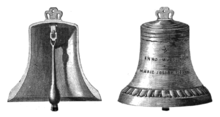Bolognese bell ringing art
The Bolognese bell ringing system took shape during the Middle Ages, and was perfected in the 19th century. It is a form of full circle ringing.
History
During the 16th century there was a competitive spirit between Rome and Bologna. At that time the Basilica of San Petronio in Bologna was still under construction, and was intended to be greater than St. Peter's Basilica in Rome. Both cities were part of the Papal States, and both were considered capital cities of art and music.
There was also competition between two teams of bell ringers; from Bologna's Basilica of San Petronio and from Rome's Santa Cecilia's Church. Eager to prove their skills, the Bolognese bell ringers devised a regular and accurate method of ringing: each bell would have to ring once per rotation. This method soon spread through the city and its many bell towers, and reached nearby cities such as Ferrara, Modena and Faenza.
Description
This bell ringing system was originally designed for an ensemble of four or five bells. Nowadays it is also sometimes used for a set of six bells.
The bells are never counterbalanced. They are mounted on a wooden structure called the castle, and flanked by a wooden support called the goat. The bells are not very heavy, as the rotation has to be fast. Generally, every bell that weighs less than 800 kg (16 cwt) is rung by one person. The heaviest bell used with this system is in Bologna Cathedral, and is called la Nonna ("the Granny") and weighs 3.3 tonnes. Thirteen people are needed to ring a scappata or a calata with it.
In this method, the bell ringers have to be at the top of the bell tower, in contact with the bells. Mechanical devices are not allowed.
Bell ringers can ring in two different positions:
- within the castle (in front of the bells), pulling the ropes and controlling the clapper
- above the castle, where they can help to raise the bell with their feet and then move it by pulling and pushing the goat. These ringers are called travaroli, because they stand on travi, girders.
Techniques
A classical doppio alla bolognese is a peal composed of three parts:
- Scappata ("run"). This is the start of every doppio. The bells, which are in resting position (mouth downward) are pulled with ropes tied to the goat. The clapper may be pushed away or pulled to ring the bell when the rotation is not sufficient. This phase ends when all the bell ringers can rotate their bell through 360 degrees, stop it with the bell's mouth upward and continue changing direction after every rotation.
- Pezzo in piedi ("standing piece"). This is the natural continuation of the scappata, but during this phase the ringers can control every rotation of the bells, and thus also change the order in which they play. This order determines the tune which is rung. In this phase the bells reach their maximum rotation and speed, and so protective measures are required for safety reasons: to prevent unexpected violent pulls, the bell ringer has their left shoulder under an espalier, which is part of the castle.
- Calata ("descent"). This is the conclusion of the peal, and is very similar to the scappata. During this phase the bells have to be brought down by reducing their rotation while ringing.
There is also another type of peal Tirata bassa ("low pull"), which is rung entirely as a single scappata. The clapper must be pulled and pushed to play in the right order.
See also
| External video | |
|---|---|
External links
- Video of a simple concert in Bologna's Cathedral, with the greatest bell playable in this way
- Video of a nice "scappata" in the Cathedral of Ferrara
- This is how one bell is played with ropes
- (in Italian) Maurizio Barilli's good explanation of the "Bolognese bell ringing art"
- (in Italian) The "Bolognese bell ringing art" explained by campanologia.org
- (in Italian) The Official Site of the "Unione Campanari Bolognesi"
